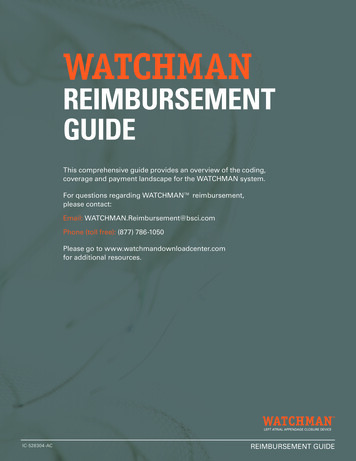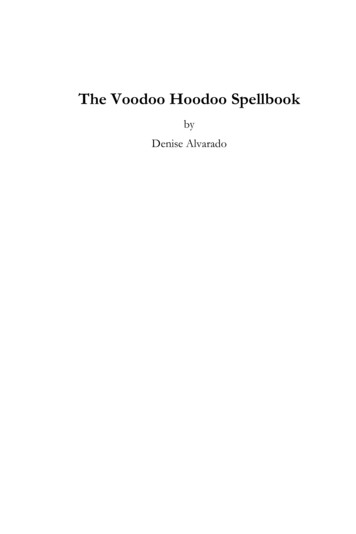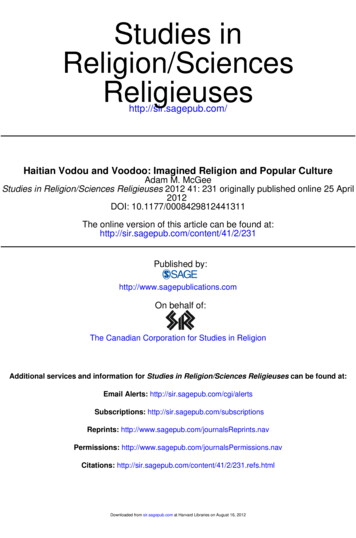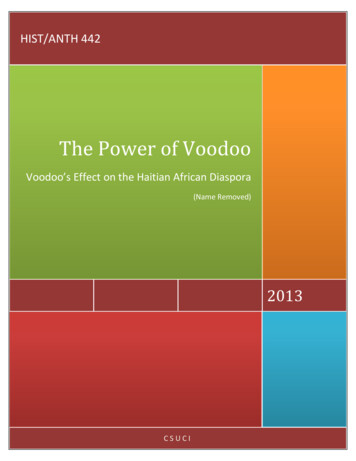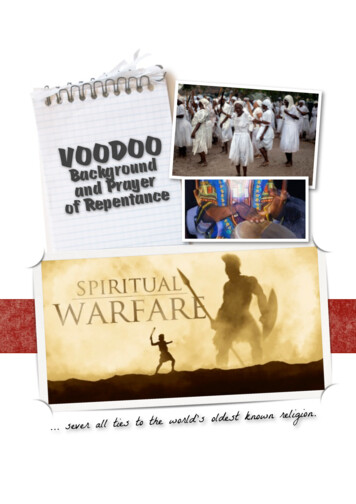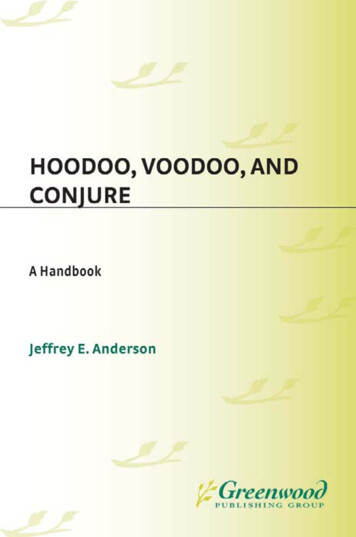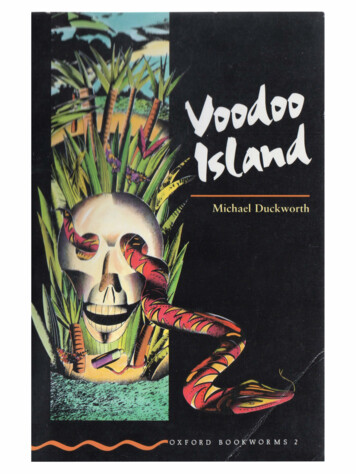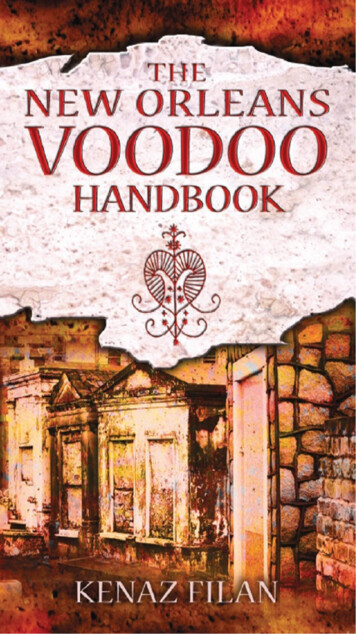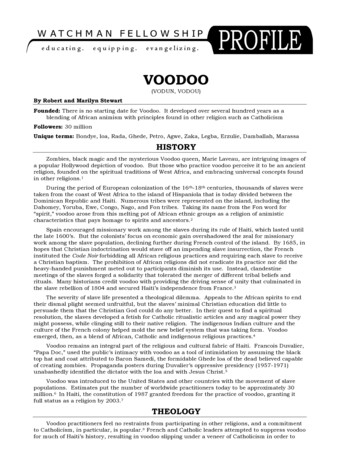
Transcription
VOODOO(VODUN, VODOU)By Robert and Marilyn StewartFounded: There is no starting date for Voodoo. It developed over several hundred years as ablending of African animism with principles found in other religion such as CatholicismFollowers: 30 millionUnique terms: Bondye, loa, Rada, Ghede, Petro, Agwe, Zaka, Legba, Erzulie, Damballah, MarassaHISTORYZombies, black magic and the mysterious Voodoo queen, Marie Laveau, are intriguing images ofa popular Hollywood depiction of voodoo. But those who practice voodoo perceive it to be an ancientreligion, founded on the spiritual traditions of West Africa, and embracing universal concepts foundin other religions.1During the period of European colonization of the 16th-18th centuries, thousands of slaves weretaken from the coast of West Africa to the island of Hispaniola that is today divided between theDominican Republic and Haiti. Numerous tribes were represented on the island, including theDahomey, Yoruba, Ewe, Congo, Nago, and Fon tribes. Taking its name from the Fon word for“spirit,” voodoo arose from this melting pot of African ethnic groups as a religion of animisticcharacteristics that pays homage to spirits and ancestors.2Spain encouraged missionary work among the slaves during its rule of Haiti, which lasted untilthe late 1600’s. But the colonists’ focus on economic gain overshadowed the zeal for missionarywork among the slave population, declining further during French control of the island. By 1685, inhopes that Christian indoctrination would stave off an impending slave insurrection, the Frenchinstituted the Code Noir forbidding all African religious practices and requiring each slave to receivea Christian baptism. The prohibition of African religions did not eradicate its practice nor did theheavy-handed punishment meted out to participants diminish its use. Instead, clandestinemeetings of the slaves forged a solidarity that tolerated the merger of different tribal beliefs andrituals. Many historians credit voodoo with providing the driving sense of unity that culminated inthe slave rebellion of 1804 and secured Haiti’s independence from France.3The severity of slave life presented a theological dilemma. Appeals to the African spirits to endtheir dismal plight seemed unfruitful, but the slaves’ minimal Christian education did little topersuade them that the Christian God could do any better. In their quest to find a spiritualresolution, the slaves developed a fetish for Catholic ritualistic articles and any magical power theymight possess, while clinging still to their native religion. The indigenous Indian culture and theculture of the French colony helped mold the new belief system that was taking form. Voodooemerged, then, as a blend of African, Catholic and indigenous religious practices.4Voodoo remains an integral part of the religious and cultural fabric of Haiti. Francois Duvalier,“Papa Doc,” used the public’s intimacy with voodoo as a tool of intimidation by assuming the blacktop hat and coat attributed to Baron Samedi, the formidable Ghede loa of the dead believed capableof creating zombies. Propaganda posters during Duvalier’s oppressive presidency (1957-1971)unabashedly identified the dictator with the loa and with Jesus Christ.5Voodoo was introduced to the United States and other countries with the movement of slavepopulations. Estimates put the number of worldwide practitioners today to be approximately 30million.6 In Haiti, the constitution of 1987 granted freedom for the practice of voodoo, granting itfull status as a religion by 2003.7THEOLOGYVoodoo practitioners feel no restraints from participating in other religions, and a commitmentto Catholicism, in particular, is popular.8 French and Catholic leaders attempted to suppress voodoofor much of Haiti’s history, resulting in voodoo slipping under a veneer of Catholicism in order to
THE BEST RESOURCE COLLECTION ON CULTS AND RELIGIONSThe Watchman Fellowship ProfileNotebook provides you with an extensive personal library of information about cults, new and alternative religions, world religions, andreligious leaders. You will have atyour fingertips over twenty years ofresearch to answer your questions,strengthen your faith, and improveyour witness to others. Over 100 ProfilesOver 400 pages of informationThe history and primary teachings ofeach groupA Christian responseto deepen your faithand enhance your outreachClick here to order your copy of the watchman fellowship profile notebookBe sure to also order your free subscription to the Watchman Fellowship Profile. Several timeseach year you will receive a new, four-page Profile that you can add to your Profile Notebook, aswell as the latest news from Watchman Fellowship. Click here to order your free subscription!
Voodoo, page 2avoid persecution. Catholicism and Voodoo in Haiti became intertwined so tightly that it has beensaid “one cannot be a worshiper of Voodoo without being a good Catholic.”9 Rosaries, pictures ofsaints and the crucifix are frequently incorporated into Haitian as well as American voodoo rituals.In Haiti, the blend has been such that many Haitians see a greater incompatibility betweenProtestantism and Catholicism than they do between voodoo and Catholicism.10There is no central authority figure or written work in voodoo by which doctrine is formulatedand beliefs are judged to be orthodox. Practices and rituals can vary significantly by region, by cityor even by individual houngan (priest) or mambo (priestess) and often reflect their influence.11The West African tribal beliefs that gave rise to Voodoo held that a supreme being namedBondye created the earth and maintained cosmic balance, but whose highly elevated stature madehim unconcerned with human needs.12 Voodoo describes the creator-supreme being (Bon Dieu orGran Tet) as all-powerful, all-knowing and even omnipresent, but distant and aloof. The term“goddess” may be applied equally well to this being who relinquished communications with humanbeings, turning that over to a host of lesser spirit beings called loa.13 God is not believed to dealdirectly with humans but meets only with the loa and considers their requests on behalf ofmankind. In Haiti, God’s name is used freely, but often denotes an idea more akin to “fate.” God isviewed as a vague and impersonal force, and requires little from human beings.14Although voodooists profess a belief in one God and creator of the universe, the rituals ofvoodoo are devoted to the worship and appeasement of other spirit beings. Service is offered to whatis sometimes called the trinity of voodoo theology: “les morts, les mysteres, et les marassa” (theDead, including ancestors, the loa and the Divine Twins).15 Their importance is reflected in astatement posted on the website of Voodoo Authentica following the flooding of New Orleans due tohurricane Katrina in August 2005: “We thank God, the Lwa, the Orisha [Santerian loa] and all ofour Ancestors for protecting our shop and our families and friends.”16Service to ancestors is an important tenet of voodoo, based on the belief that the living and thedead communicate and that ancestors have a natural affection for their descendants. Newcomers tovoodoo are often advised to begin with the simple ritual of an ancestral feast. In return for homageto ancestors, a devotee will expect guidance, healing and protection.17 Though an ancestor will notnecessarily be considered divine, or equal to a loa, he or she is considered an important conduit tospiritual and physical blessings.18Ancestral lineage is central to voodoo’s claim as an ancient religion. Though any race mayparticipate in its ritual, voodoo is described as carried “in the blood” of those from an African lineageand is offered as the explanation for voodoo’s tenacity despite a long history of oppression.19Practitioners of voodoo recognize this distinctive birthright, for without it, voodoo may be seen as“little more than another Western, superficial, New Age commercial ‘spiritual’ fad.”20Voodoo ceremonies involve recognition of the loa, the manifestations of the creator.21 Theselesser spiritual beings, also called les mysteres or les invisibles, are described as “the archetypalrepresentatives of some natural or moral principle” and in some instances are associated with aspecific element of the physical earth.22 The New Orleans Voodoo Spiritual Temple describes the loaas “intermediaries (like the saints in Catholicism) between the creator and the human world.”23Hundreds of loa are said to exist, with each individual loa identified with specific mannerismsand preferences in dress, foods, drink, trees, colors, drum rhythms and dances.24 Voodoo says theloa choose their serviteurs (worshippers), rather than the converse, and will expect devotion andattention from them. Misfortune is attributed to improper attending to the loa that “belongs” to afamily or to the loa’s altar.25 A devotee may wed a loa in a marriage ceremony performed by ahoungan or mambo in order to secure the loa’s special patronage.26Haitian voodoo says that in order “to learn about the loa you must watch the possessed.”27Trance possession is the primary method by which the loa communicate to humans.28 Whenpossessed, a person will imitate the general appearance, personality, walk and talk of a specific loa.Possession often occurs during, but is not limited to, a voodoo ritual involving dance and music.“Comparable to the New Age phenomenon of ‘channeling,’ through possession (the loa) sing, dance,tell jokes, heal the sick, and give advice.”29The loa are categorized by three primary identities: the Rada, Ghede and Petro loa. The Radaloa have clear African origins and are generally benevolent. Ceremonies to Rada are stately anddisciplined and employ white as a ceremonial color. Petro loa originate from the harsh days ofHaitian servitude and are fierce, magical and aggressive toward adversaries. Displaying redceremonial colors, Petro rituals are fast-paced and spirited. The Ghede loa are the lords of death
Voodoo, page 3and resurrection, and are identified by violet and black ceremonial colors. Those possessed by thedefiant Ghede may tell jokes, or act bawdy and lewd.30Assigning the loa to a particular group does not define the spirit’s position within a hierarchy ofbeings. Rather, voodoo believes that the many loa are manifestations of the same cosmic energy,each serving a different purpose. The Rada and Petro loas are “the same energy bent in anotherdirection and meeting divergent needs.”31 Collectively, the loa make up a central cosmic principle.Individually, the manifestation of a loa with certain “personality” traits serves to emphasize somepart of the cosmic principle.32Imagery is important in voodoo. Pictures of Catholic saints are used to visualize the essenceand personality of the loa. This identification is more a matter of putting a face to the spirit’spersonality than actually equating the loa with the saint.33 Other associations link the loa to anelement in nature such as Agwe, the loa of the seas and Cousin Zaka, the loa of agriculture. Threeloa that serve as an example of this type of association with a Catholic Saint are Legba, Erzulie andDamballah.34Legba, or Papa Legba, is central to every voodoo ceremony. Often associated with Christ orPeter the apostle, Legba is the guardian of the gate between the invisible world and the world ofhumans. As keeper of this important crossroads Legba is responsible for relaying messagesbetween the loa and mankind. Every voodoo ceremony will begin with an acknowledgment ofLegba’s position, for without his assistance the invisible world of loa would be inaccessible, therebydenying help and resources to the serviteur.35The jealous female loa, Erzulie, represents love, beauty and sensuality and demands that adevotee dedicate an area or room of his home in her honor. Erzulie is often associated with theVirgin Mary, and in the realm of nature, woods or water.36Damballah is considered as old as humanity and may be referred to as the Father, as in thefirst member of the Trinity. The serpent is the image used to represent Damballah, and unlike otherloa who communicate verbally through possession, his only sound is that of hissing. Damballah isassociated with the rainbow, but also with Saint Patrick, a Catholic saint often pictured with thesnakes of Ireland.37Distinct from the loa are the Marassa, or Divine Twins, the spirit beings said to be the first of“God’s children” and the first dead. “The worship of the Marassa is a celebration of man’s twinnednature: half matter, half metaphysical; half mortal, half immortal; half human, half divine.”38 Somehave related the Marassa to voodoo’s view of the nature of Christ, that of being half human and halfdivine.39Humans are believed to possess two “souls” or “angels,” both housed within the head of aperson. The “ti-bon-ange” or “little good soul” is essentially the personality or conscience of aperson, and is useful for moral and ethical judgments. The “big good angel” or “gros-bon-ange,” isthe seat of intelligence, memory and is often called the soul.40Good and evil in voodoo are considered intimately connected. Pain and suffering are not theresult of human failure or sin, and evil does not deserve long-term punishment. Both good and evilare seen as components of life, joined as one in a wider cosmological notion of “God.” Suffering canbe made right through the balance achieved by maintaining a proper relationship with the cosmicforces. All experiences of life are regarded as opportunities for growth and renewal.41Voodoo is an experiential system and does not look to the intervention of a supreme being formankind’s needs, but rather focuses on the actions of human beings through honoring theancestors and fulfilling commitments to the loa. The serviteur can seek answers, relief fromsuffering, or reward for service from his loa. One may offer traditional service to the loa, butcreative, personalized means
voodoo are often advised to begin with the simple ritual of an ancestral feast. In return for homage to ancestors, a devotee will expect guidance, healing and protection.17 Though an ancestor will not necessarily be considered divine, or equal to a loa, he or she is considered an important conduit to .
